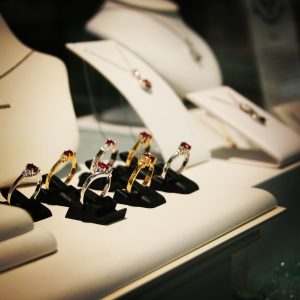We are all aware that gold is a yellow metal, in fact pure gold is an intense golden color. White gold is the result of this pure rich yellow metal alloyed (most commonly) with nickel. For some people with metal allergies the nickle can cause a discoloration or irritation of the skin. In some exceptionally rare instances, designers will use a white gold alloy that does not contain nickel but has been alloyed with palladium.
The most commonly used yellow gold alloys in the jewelry industry, 14k and 18k, contain pure gold that has been alloyed with both copper and silver. The balance of copper and silver proportions result in the metal to reflect a yellow color, however if the proportions of these two alloys are changed the metal’s hue will change. When the copper content is increased and the silver content is decreased, the result is a gold alloy that has a strong red (or pink) tone- rose gold.
When the copper content is decreased and the silver content is increased, the result is a gold alloy with a strong green tone- green gold.
It is important to note that neither rose nor green gold has a lower pure gold content than yellow gold, just a different color.
10k 14k 18k 22k and 24k gold are referring to the actual gold content of a metal. This is directly related to the color, durability and price of the metal.
- 24k gold is pure gold that has little to no use within the jewelry industry because it is simply too soft to withstand the everyday wear of jewelry. It has a bold yellow color unlike anything else in the world.
- 22k gold is 92% pure gold with 8% alloy. This is sometimes used in designer jewelry. 22k yellow gold maintains the full color of pure gold but the alloys give the metal a little more durability for wear but is still not recommended for everyday wear.
- 18k gold is 75% pure gold with 25% alloys. This is the highest quality gold that is suitable for wearing everyday but is still quite soft. 18k gold can be yellow, white, green or rose depending on which metals it has been alloyed with.
- 14k gold is 58% pure gold with 42% alloy. It is the most durable gold used in the jewelry industry. It is most suitable for the high intensity wear of today’s women. 14k yellow gold still has a beautiful yellow color with a slightly redder tone than 18k. It can be yellow, white, green or rose depending on which metals it has been alloyed with.
- 10k gold is 41% pure gold with 59% alloy. It is the most affordable gold used in jewelry in the United States. Its color has a more coppery tone than yellow due to the lower pure gold content.
Each of these white metals has unique attributes that have both benefits and disadvantages. Here is a brief overview of the more common characteristics.
- Sterling Silver is a very affordable, pure white metal however it is very soft and therefore not suitable for high intensity wear or for securing expensive precious gemstones. Sterling Silver can be modified, melted, reshaped and soldered.
- Platinum is another pure white metal. It is tremendously dense (approx 60% more so than white gold) and has an extremely high melting point. These two characteristics translate to a metal that is very difficult to solder, reshape and polish, thus driving the cost of platinum jewelry and platinum jewelry repair much higher than its more common counterpart- white gold. The high density however, makes the metal ideal for securing precious gemstones and will wear down much more slowly over time than gold. Platinum can be modified, melted, reshaped and soldered.
- White Gold is a not a true white metal. Because pure gold is a yellow metal, this color presents itself as subtle undertone giving white gold a “warm white” tone. Most white gold jewelry is plated with Rhodium (a pure white metal from the platinum family) to give a purer white look. This plating will wear away over time or with high intensity use. White gold can be modified, melted, reshaped and soldered.
- Titanium is an extremely hard, gunmetal grey metal. It is extremely light and affordable but has some downsides as well. Titanium can be cut (for example rings can be cut off if needed) but it cannot be reworked or sized like platinum, gold or silver using traditional jewelers tools. It is also more prone to everyday scuffs and scratches. Titanium’s darker tones, hardness and affordability make it a favorite for young men’s wedding bands.
- Tungsten is another extremely hard, gunmetal grey metal but unlike titanium it is very dense and heavy. Tungsten’s nearly scratch proof quality coupled with its affordability make it another favorite for young men’s wedding bands.
The short answer is no, having your ring sized does not change the value. Jewelry valuations are typically based on the insurance replacement cost of the item (what would it cost to recreate your ring brand new) however if the structure of the ring has to be modified dramatically then in some instances it can affect the cost to reproduce it. A simple example would be sizing a ring either up or down more than 3 or 4 sizes. Even this shouldn’t change valuations much unless the ring features a very wide and heavy shank.



